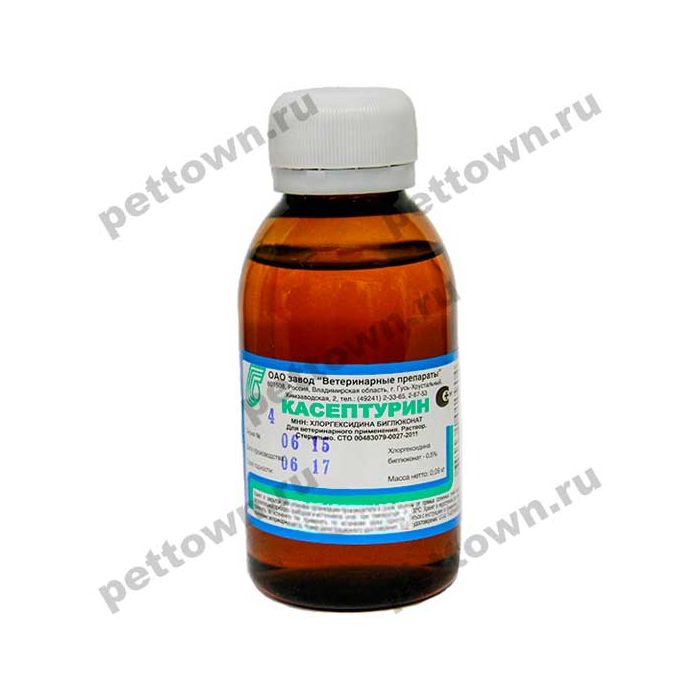Casepturine 90g
DESCRIPTION
Kasepturin (Kasepturinum) is a veterinary drug as a therapeutic, prophylactic and antiseptic agent. In appearance, Casepturin is a homogeneous transparent liquid of yellow color of various shades.
COMPOSITION
Casepturin contains 0.5% chlorhexidine bigluconate as an active ingredient, and ethyl alcohol, a dye and distilled water as auxiliary substances.
PHARMACOLOGICAL PROPERTIES
Pharmacotherapeutic group: antiseptic agents.
Casepturin has a complex anti-inflammatory, antiseptic (antimicrobial), fungicidal and virucidal effect.
Chlorhexidine, which is part of the Kasepturin preparation, has bactericidal activity against gram-negative and gram-positive aerobic and anaerobic bacteria (including pathogens of tuberculosis, Escherichia coli, staphylococci, streptococci, salmonella), fungicidal activity against yeast-like and trichitic fungi of the genus Kaphylococcus action against lipophilic viruses.
Chlorhexidine neutralizes amino groups of cell proteins, passes into the membrane of bacterial cells, stops at the cytoplasm and penetrates into the membrane function, thereby blocking oxygen consumption, which contributes to a decrease in the level of ATP in cells, as a result cells die.
In the presence of blood, pus, various secrets and organic substances, the antibacterial effect of the drug According to the degree of effect on the body, Kasepturin belongs to low-fat substances (hazard class 4 according to GOST 12.1.007-76) is preserved.
In terms of the degree of impact on the body, Kasepturin belongs to low-salty substances (hazard class 4 according to GOST 12.1.007-76).
PURPOSE
Casepturin is used as a therapeutic and prophylactic and antiseptic agent for: treatment and treatment of purulent wounds, abscesses. infected burns, bacterial and fungal skin diseases; processing of postoperative sutures: preparation of the operating and injection fields; disinfection of tissues during castration, childbirth; processing of the umbilical stump in newborns; treatment of scratches, abrasions, superficial infected wounds and other minor traumatic injuries.
DOSAGE AND APPLICATION
When working with Kasepturin, you should follow the general rules of personal hygiene and safety measures provided for when working with medicines.
Casepturin should be used for external use only. The drug is highly flammable; therefore, contact with open flame and switched on heating devices should not be allowed. Smoking, drinking and eating are not allowed during work. After finishing work, wash your hands with warm water and soap. It is forbidden to use empty vials from under the drug for domestic purposes, they are disposed of with household waste.
In case of accidental contact of the drug with the skin or mucous membranes of the eyes, they must be rinsed with plenty of water. People with hypersensitivity to the components of the drug should avoid direct contact with the drug Casepturin. In case of allergic reactions or accidental ingestion of the drug into the human body, you should immediately contact a medical institution (you should have instructions for use of the drug or a label with you).
Casepturin is applied topically to the affected skin with a tampon or sterile gauze pad or as an irrigation. Depending on the size of the lesion, the amount of solution should be such as to completely wet the treated surface, taking into account the streaks and wound cavities. In the case of severe contamination of the wound, the treatment is carried out until the visible dirt is completely removed. Casepturin is used every day 1-2 times a day. Then, with the beginning of the granulation and healing process, the drug can be applied more than once every 2-3 days. The course of treatment is 7-14 days.
During antiseptic treatment of the operating field, the skin is successively wiped twice with separate sterile gauze tampons, abundantly moistened with the preparation Casepturin. The holding time after the end of processing is 2 minutes.
The injection field is wiped (in one direction) with a sterile cotton swab moistened with this antiseptic. The holding time after the end of processing is 1 minute.
Surgical instruments and work surfaces are treated with a clean sponge moistened with Casepturin and by soaking. For rapid sterilization of instruments, use the same solution for 5 minutes.
When processing surgical or examination (synthetic) gloves, they are wiped (in one direction) with a cotton swab abundantly moistened with Casepturin.
SPECIAL INSTRUCTIONS
The peculiarities of the action of the drug during its first use and when it is canceled have not been established.
Violations of the recommended processing times for animals should be avoided, as this can lead to a decrease in effectiveness. If one or more treatments are missed with a drug, its use should be continued as soon as possible according to the instructions, the interval between treatments does not change.
Livestock products during and after the use of the drug Kasepurin are used without restrictions.
CONTRAINDICATIONS
A contraindication to the use of the drug is the individual hypersensitivity of the animal to chlorhexidine and other components of the drug.
SIDE EFFECTS
As a rule, there are no side effects and complications when using the drug Casepturin in accordance with this instruction.
In case of increased individual sensitivity of the animal to the components of the drug and signs of skin irritation (redness of the skin, itching), the treatment is stopped, the drug is washed off with water. No additional treatment is required.
SHELF LIFE AND STORAGE
The shelf life of the drug Kasepturin, subject to storage conditions in the manufacturer's closed packaging, is 2 years from the date of production.
Casepturin is stored in a closed manufacturer's packaging in a place protected from direct sunlight, away from heating devices and sources of fire, at a temperature from minus 40 В° C to 30 В° C.
PACKAGING
Casepturin is produced packaged in 90 g glass bottles
Specifications
Item segment
Stop sheet
Bonus points
0
KolVUP
80
Manufacturer
Factory Veterinary drugs
Teaser
treatment of operating and injection fields, washing of operating wounds, treatment of surgical gloves, infected burns, bacterial and fungal skin diseases

